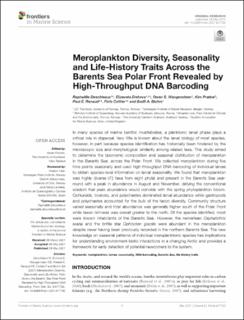| dc.contributor.author | Descoteaux, Raphaelle | |
| dc.contributor.author | Ershova, Elizaveta | |
| dc.contributor.author | Wangensteen, Owen S. | |
| dc.contributor.author | Præbel, Kim | |
| dc.contributor.author | Renaud, Paul Eric | |
| dc.contributor.author | Cottier, Finlo Robert | |
| dc.contributor.author | Bluhm, Bodil | |
| dc.date.accessioned | 2021-06-04T08:56:29Z | |
| dc.date.available | 2021-06-04T08:56:29Z | |
| dc.date.created | 2021-05-30T16:55:10Z | |
| dc.date.issued | 2021 | |
| dc.identifier.citation | Frontiers in Marine Science. 2021, 8 . | en_US |
| dc.identifier.issn | 2296-7745 | |
| dc.identifier.uri | https://hdl.handle.net/11250/2757649 | |
| dc.description.abstract | In many species of marine benthic invertebrates, a planktonic larval phase plays a critical role in dispersal. Very little is known about the larval biology of most species, however, in part because species identification has historically been hindered by the microscopic size and morphological similarity among related taxa. This study aimed to determine the taxonomic composition and seasonal distribution of meroplankton in the Barents Sea, across the Polar Front. We collected meroplankton during five time points seasonally and used high-throughput DNA barcoding of individual larvae to obtain species-level information on larval seasonality. We found that meroplankton was highly diverse (72 taxa from eight phyla) and present in the Barents Sea year-round with a peak in abundance in August and November, defying the conventional wisdom that peak abundance would coincide with the spring phytoplankton bloom. Ophiuroids, bivalves, and polychaetes dominated larval abundance while gastropods and polychaetes accounted for the bulk of the taxon diversity. Community structure varied seasonally and total abundance was generally higher south of the Polar Front while taxon richness was overall greater to the north. Of the species identified, most were known inhabitants of the Barents Sea. However, the nemertean Cephalothrix iwatai and the brittle star Ophiocten gracilis were abundant in the meroplankton despite never having been previously recorded in the northern Barents Sea. The new knowledge on seasonal patterns of individual meroplanktonic species has implications for understanding environment-biotic interactions in a changing Arctic and provides a framework for early detection of potential newcomers to the system. | en_US |
| dc.language.iso | eng | en_US |
| dc.title | Meroplankton Diversity, Seasonality and Life-History Traits Across the Barents Sea Polar Front Revealed by High-Throughput DNA Barcoding | en_US |
| dc.type | Peer reviewed | en_US |
| dc.type | Journal article | en_US |
| dc.description.version | publishedVersion | en_US |
| dc.source.pagenumber | 19 | en_US |
| dc.source.volume | 8 | en_US |
| dc.source.journal | Frontiers in Marine Science | en_US |
| dc.identifier.doi | 10.3389/fmars.2021.677732 | |
| dc.identifier.cristin | 1912691 | |
| cristin.ispublished | true | |
| cristin.fulltext | original | |
| cristin.qualitycode | 1 | |
